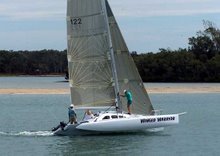 Jorn came by to spend some days with us, fishing, and helping me out with the lamination of the outer skin. Here we unwrap the last half (did one side at a time). If I had those synthetic staples then maybe I could do both in one go, but I don't mind splitting the process into two sessions. I use the same bag, sealing it at the stern and bow. It is so big that I just cut of the sealant tape at one end and reused it. I can still use it for the other half.
Jorn came by to spend some days with us, fishing, and helping me out with the lamination of the outer skin. Here we unwrap the last half (did one side at a time). If I had those synthetic staples then maybe I could do both in one go, but I don't mind splitting the process into two sessions. I use the same bag, sealing it at the stern and bow. It is so big that I just cut of the sealant tape at one end and reused it. I can still use it for the other half.  Checking the quality and it is fine. Sorry I did not use camera while laminating but I was alone the first half, will shot some the next half.
Checking the quality and it is fine. Sorry I did not use camera while laminating but I was alone the first half, will shot some the next half.Note hat competition: Who got the highest stupid looking hat. And the winner is me off cause(to the left just to be sure)


























